Nike ERP Implementation Case Study: Problems, Solutions, and Analysis
VerifiedAdded on 2022/09/09
|9
|1765
|26
Case Study
AI Summary
This case study analyzes Nike's Enterprise Resource Planning (ERP) implementation, focusing on the application of Organizational Project Management (OPM3) to identify and address problems. The analysis explores the challenges encountered during the ERP rollout, including issues related to training, data, and the phased implementation approach. It highlights the importance of a structured, step-by-step approach, and the use of OPM3 to assess capabilities and weaknesses. The study examines the reasons behind Nike's successful implementation, emphasizing the role of employee training and business re-engineering. The document also supports the phased rollout strategy, detailing how it facilitated learning and adaptation. Finally, it provides insights into the company's decision-making, and the importance of customer focus during project implementation. This case study helps students understand the practical application of project management principles in ERP implementation.
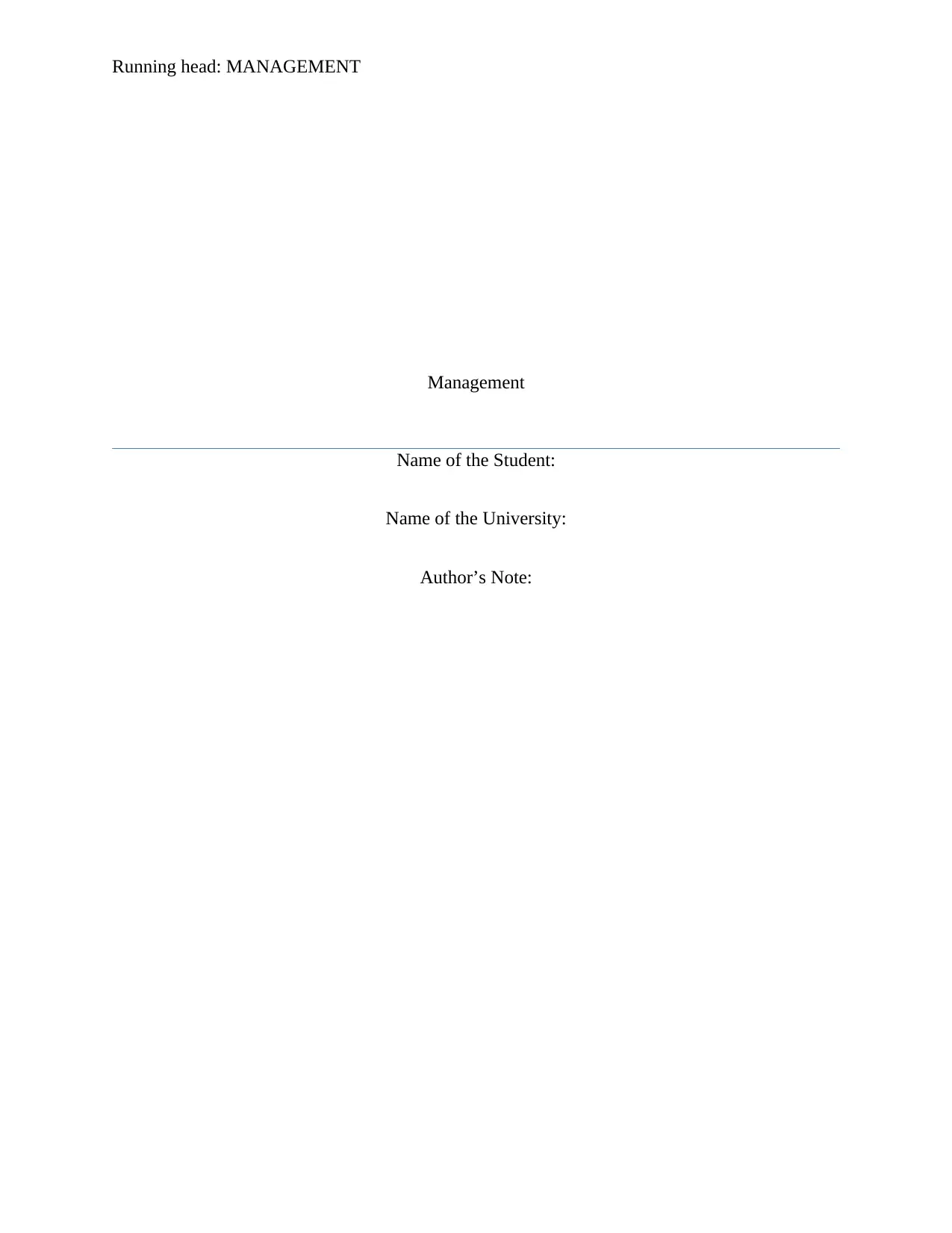
Running head: MANAGEMENT
Management
Name of the Student:
Name of the University:
Author’s Note:
Management
Name of the Student:
Name of the University:
Author’s Note:
Paraphrase This Document
Need a fresh take? Get an instant paraphrase of this document with our AI Paraphraser
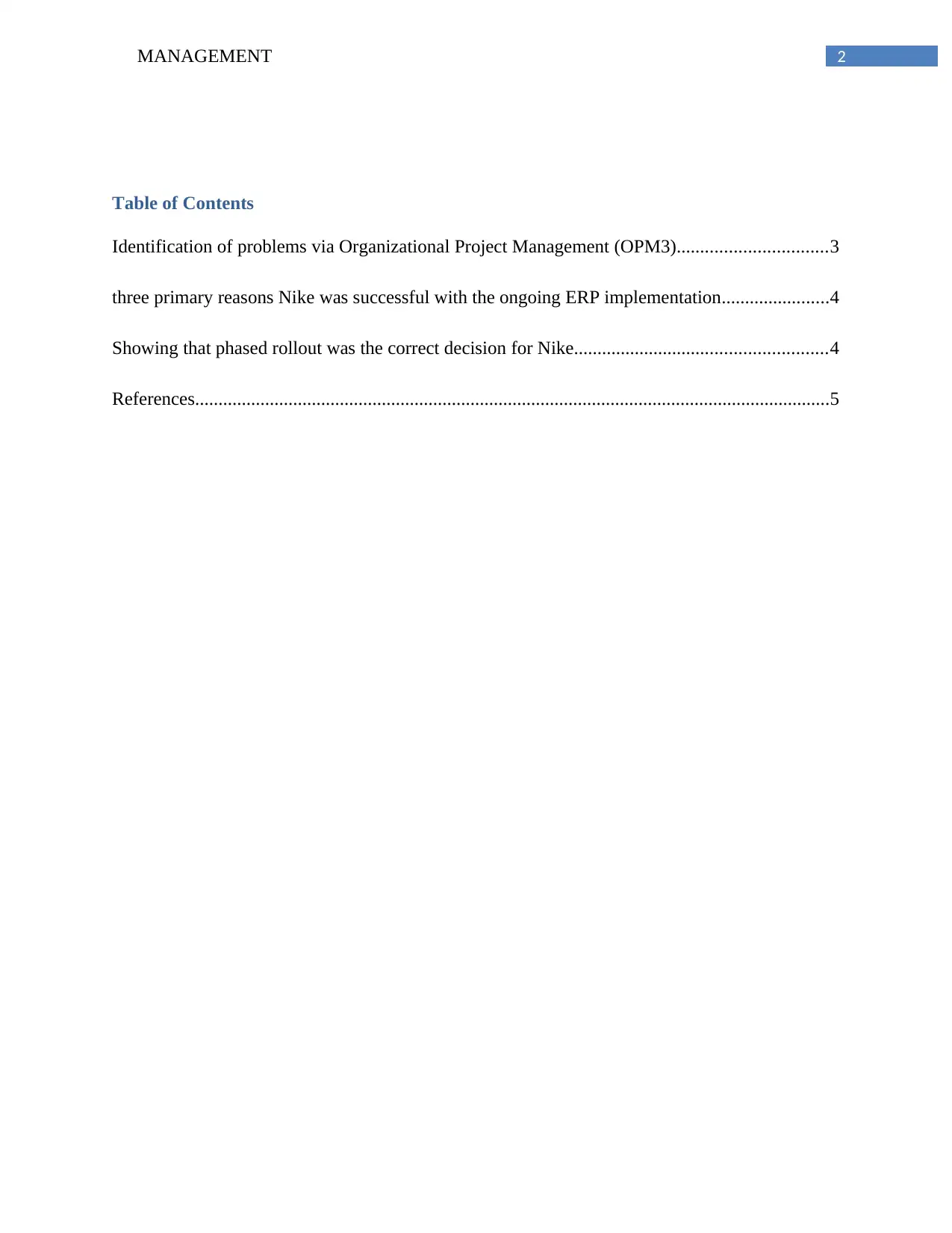
2MANAGEMENT
Table of Contents
Identification of problems via Organizational Project Management (OPM3)................................3
three primary reasons Nike was successful with the ongoing ERP implementation.......................4
Showing that phased rollout was the correct decision for Nike......................................................4
References........................................................................................................................................5
Table of Contents
Identification of problems via Organizational Project Management (OPM3)................................3
three primary reasons Nike was successful with the ongoing ERP implementation.......................4
Showing that phased rollout was the correct decision for Nike......................................................4
References........................................................................................................................................5
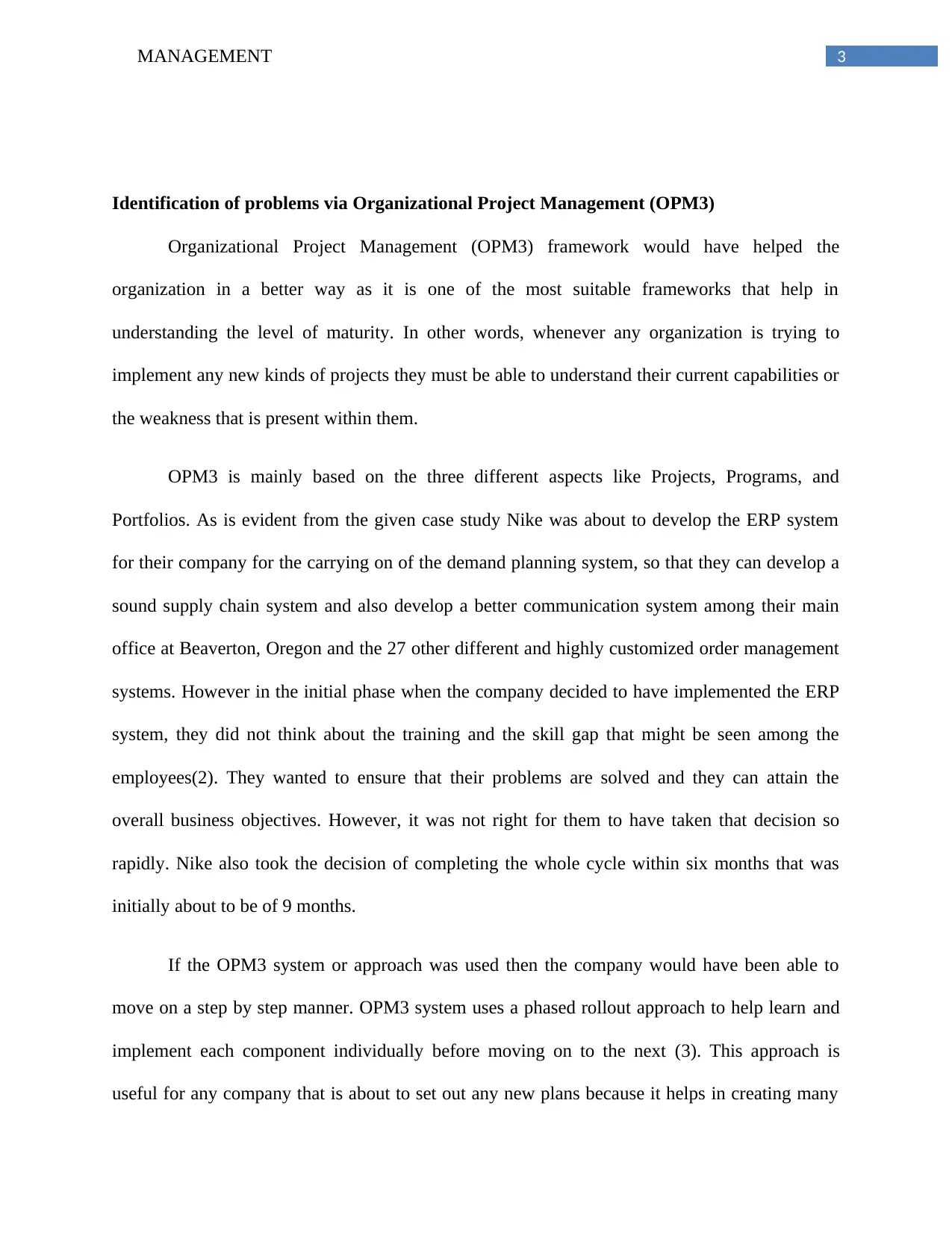
3MANAGEMENT
Identification of problems via Organizational Project Management (OPM3)
Organizational Project Management (OPM3) framework would have helped the
organization in a better way as it is one of the most suitable frameworks that help in
understanding the level of maturity. In other words, whenever any organization is trying to
implement any new kinds of projects they must be able to understand their current capabilities or
the weakness that is present within them.
OPM3 is mainly based on the three different aspects like Projects, Programs, and
Portfolios. As is evident from the given case study Nike was about to develop the ERP system
for their company for the carrying on of the demand planning system, so that they can develop a
sound supply chain system and also develop a better communication system among their main
office at Beaverton, Oregon and the 27 other different and highly customized order management
systems. However in the initial phase when the company decided to have implemented the ERP
system, they did not think about the training and the skill gap that might be seen among the
employees(2). They wanted to ensure that their problems are solved and they can attain the
overall business objectives. However, it was not right for them to have taken that decision so
rapidly. Nike also took the decision of completing the whole cycle within six months that was
initially about to be of 9 months.
If the OPM3 system or approach was used then the company would have been able to
move on a step by step manner. OPM3 system uses a phased rollout approach to help learn and
implement each component individually before moving on to the next (3). This approach is
useful for any company that is about to set out any new plans because it helps in creating many
Identification of problems via Organizational Project Management (OPM3)
Organizational Project Management (OPM3) framework would have helped the
organization in a better way as it is one of the most suitable frameworks that help in
understanding the level of maturity. In other words, whenever any organization is trying to
implement any new kinds of projects they must be able to understand their current capabilities or
the weakness that is present within them.
OPM3 is mainly based on the three different aspects like Projects, Programs, and
Portfolios. As is evident from the given case study Nike was about to develop the ERP system
for their company for the carrying on of the demand planning system, so that they can develop a
sound supply chain system and also develop a better communication system among their main
office at Beaverton, Oregon and the 27 other different and highly customized order management
systems. However in the initial phase when the company decided to have implemented the ERP
system, they did not think about the training and the skill gap that might be seen among the
employees(2). They wanted to ensure that their problems are solved and they can attain the
overall business objectives. However, it was not right for them to have taken that decision so
rapidly. Nike also took the decision of completing the whole cycle within six months that was
initially about to be of 9 months.
If the OPM3 system or approach was used then the company would have been able to
move on a step by step manner. OPM3 system uses a phased rollout approach to help learn and
implement each component individually before moving on to the next (3). This approach is
useful for any company that is about to set out any new plans because it helps in creating many
⊘ This is a preview!⊘
Do you want full access?
Subscribe today to unlock all pages.

Trusted by 1+ million students worldwide
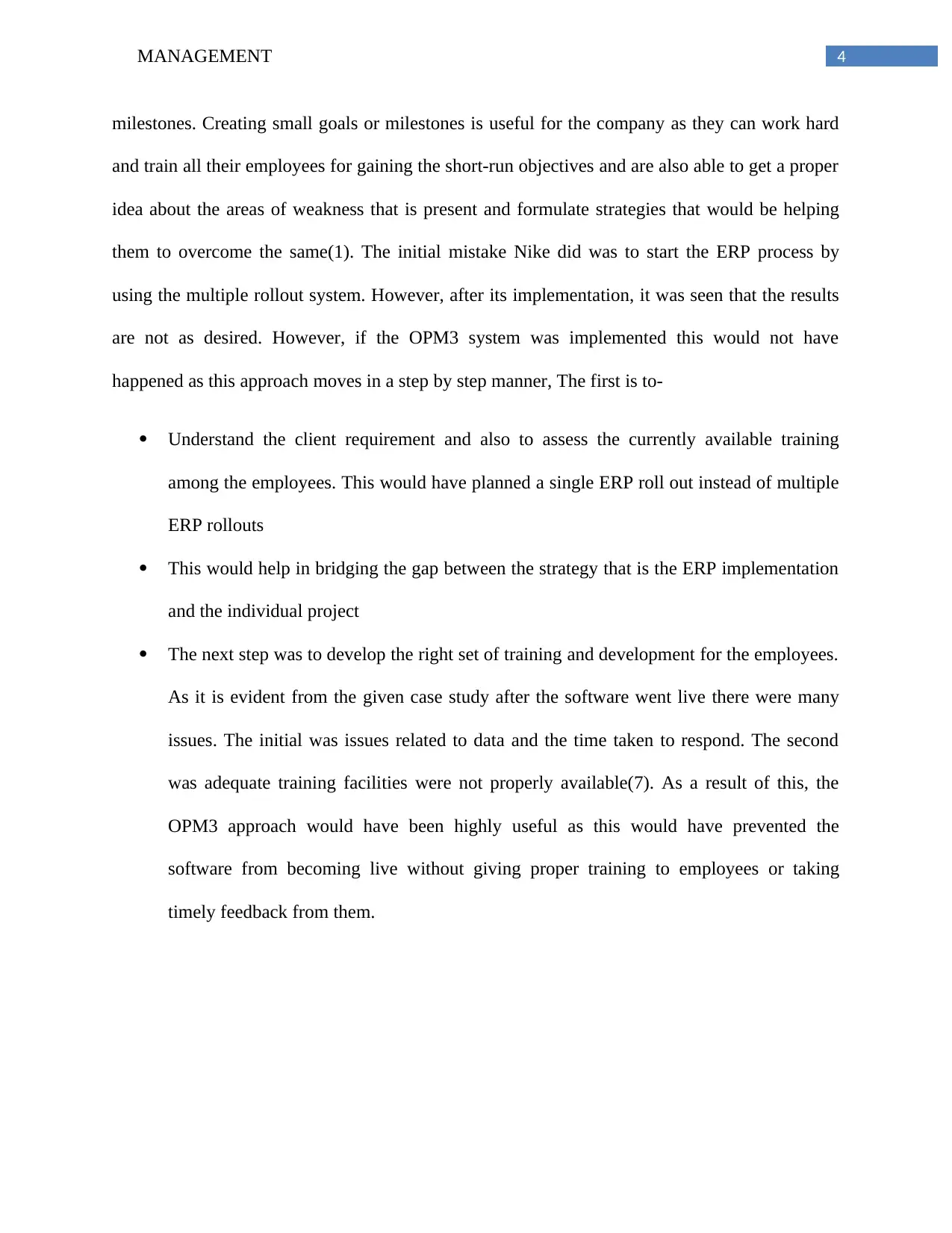
4MANAGEMENT
milestones. Creating small goals or milestones is useful for the company as they can work hard
and train all their employees for gaining the short-run objectives and are also able to get a proper
idea about the areas of weakness that is present and formulate strategies that would be helping
them to overcome the same(1). The initial mistake Nike did was to start the ERP process by
using the multiple rollout system. However, after its implementation, it was seen that the results
are not as desired. However, if the OPM3 system was implemented this would not have
happened as this approach moves in a step by step manner, The first is to-
Understand the client requirement and also to assess the currently available training
among the employees. This would have planned a single ERP roll out instead of multiple
ERP rollouts
This would help in bridging the gap between the strategy that is the ERP implementation
and the individual project
The next step was to develop the right set of training and development for the employees.
As it is evident from the given case study after the software went live there were many
issues. The initial was issues related to data and the time taken to respond. The second
was adequate training facilities were not properly available(7). As a result of this, the
OPM3 approach would have been highly useful as this would have prevented the
software from becoming live without giving proper training to employees or taking
timely feedback from them.
milestones. Creating small goals or milestones is useful for the company as they can work hard
and train all their employees for gaining the short-run objectives and are also able to get a proper
idea about the areas of weakness that is present and formulate strategies that would be helping
them to overcome the same(1). The initial mistake Nike did was to start the ERP process by
using the multiple rollout system. However, after its implementation, it was seen that the results
are not as desired. However, if the OPM3 system was implemented this would not have
happened as this approach moves in a step by step manner, The first is to-
Understand the client requirement and also to assess the currently available training
among the employees. This would have planned a single ERP roll out instead of multiple
ERP rollouts
This would help in bridging the gap between the strategy that is the ERP implementation
and the individual project
The next step was to develop the right set of training and development for the employees.
As it is evident from the given case study after the software went live there were many
issues. The initial was issues related to data and the time taken to respond. The second
was adequate training facilities were not properly available(7). As a result of this, the
OPM3 approach would have been highly useful as this would have prevented the
software from becoming live without giving proper training to employees or taking
timely feedback from them.
Paraphrase This Document
Need a fresh take? Get an instant paraphrase of this document with our AI Paraphraser
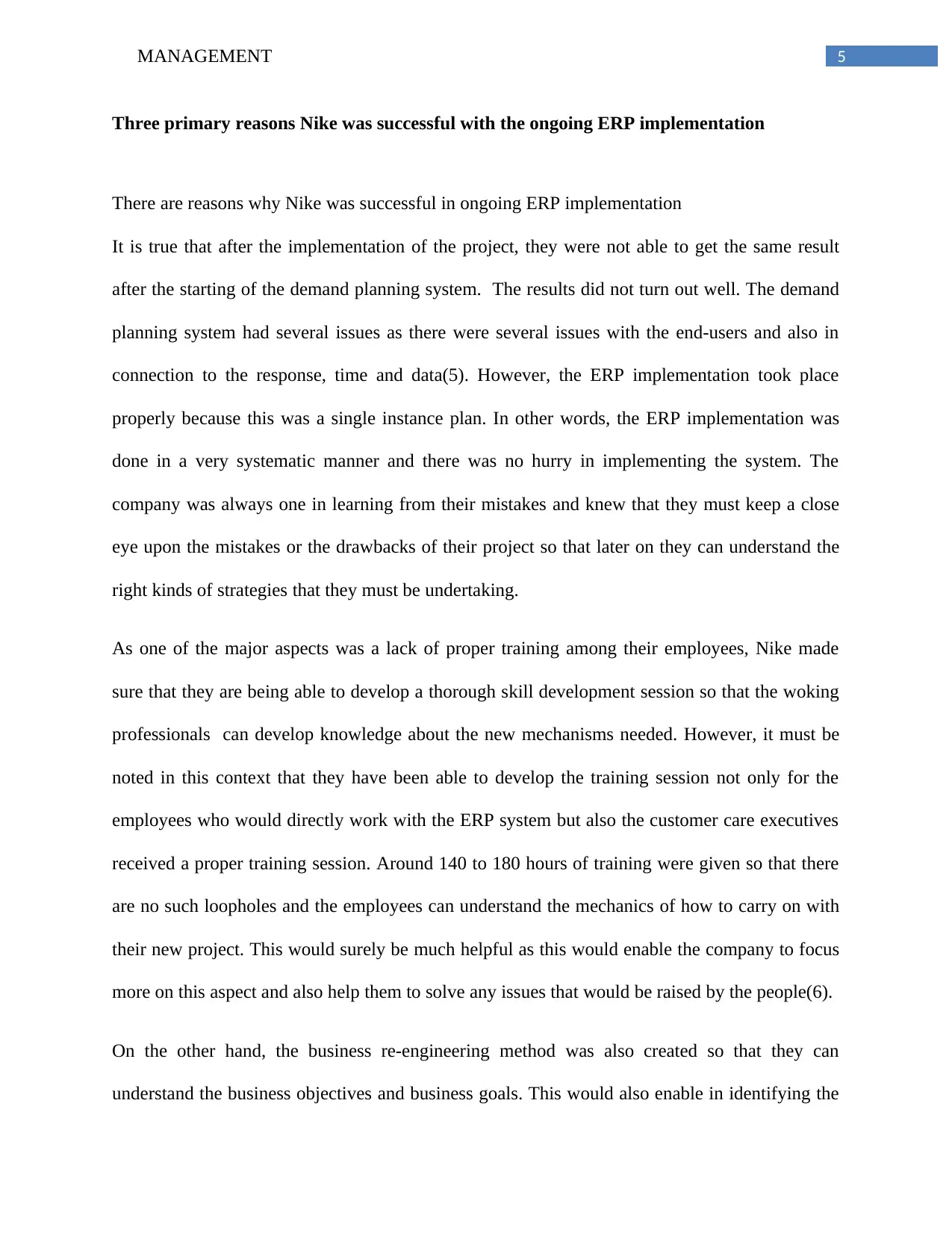
5MANAGEMENT
Three primary reasons Nike was successful with the ongoing ERP implementation
There are reasons why Nike was successful in ongoing ERP implementation
It is true that after the implementation of the project, they were not able to get the same result
after the starting of the demand planning system. The results did not turn out well. The demand
planning system had several issues as there were several issues with the end-users and also in
connection to the response, time and data(5). However, the ERP implementation took place
properly because this was a single instance plan. In other words, the ERP implementation was
done in a very systematic manner and there was no hurry in implementing the system. The
company was always one in learning from their mistakes and knew that they must keep a close
eye upon the mistakes or the drawbacks of their project so that later on they can understand the
right kinds of strategies that they must be undertaking.
As one of the major aspects was a lack of proper training among their employees, Nike made
sure that they are being able to develop a thorough skill development session so that the woking
professionals can develop knowledge about the new mechanisms needed. However, it must be
noted in this context that they have been able to develop the training session not only for the
employees who would directly work with the ERP system but also the customer care executives
received a proper training session. Around 140 to 180 hours of training were given so that there
are no such loopholes and the employees can understand the mechanics of how to carry on with
their new project. This would surely be much helpful as this would enable the company to focus
more on this aspect and also help them to solve any issues that would be raised by the people(6).
On the other hand, the business re-engineering method was also created so that they can
understand the business objectives and business goals. This would also enable in identifying the
Three primary reasons Nike was successful with the ongoing ERP implementation
There are reasons why Nike was successful in ongoing ERP implementation
It is true that after the implementation of the project, they were not able to get the same result
after the starting of the demand planning system. The results did not turn out well. The demand
planning system had several issues as there were several issues with the end-users and also in
connection to the response, time and data(5). However, the ERP implementation took place
properly because this was a single instance plan. In other words, the ERP implementation was
done in a very systematic manner and there was no hurry in implementing the system. The
company was always one in learning from their mistakes and knew that they must keep a close
eye upon the mistakes or the drawbacks of their project so that later on they can understand the
right kinds of strategies that they must be undertaking.
As one of the major aspects was a lack of proper training among their employees, Nike made
sure that they are being able to develop a thorough skill development session so that the woking
professionals can develop knowledge about the new mechanisms needed. However, it must be
noted in this context that they have been able to develop the training session not only for the
employees who would directly work with the ERP system but also the customer care executives
received a proper training session. Around 140 to 180 hours of training were given so that there
are no such loopholes and the employees can understand the mechanics of how to carry on with
their new project. This would surely be much helpful as this would enable the company to focus
more on this aspect and also help them to solve any issues that would be raised by the people(6).
On the other hand, the business re-engineering method was also created so that they can
understand the business objectives and business goals. This would also enable in identifying the
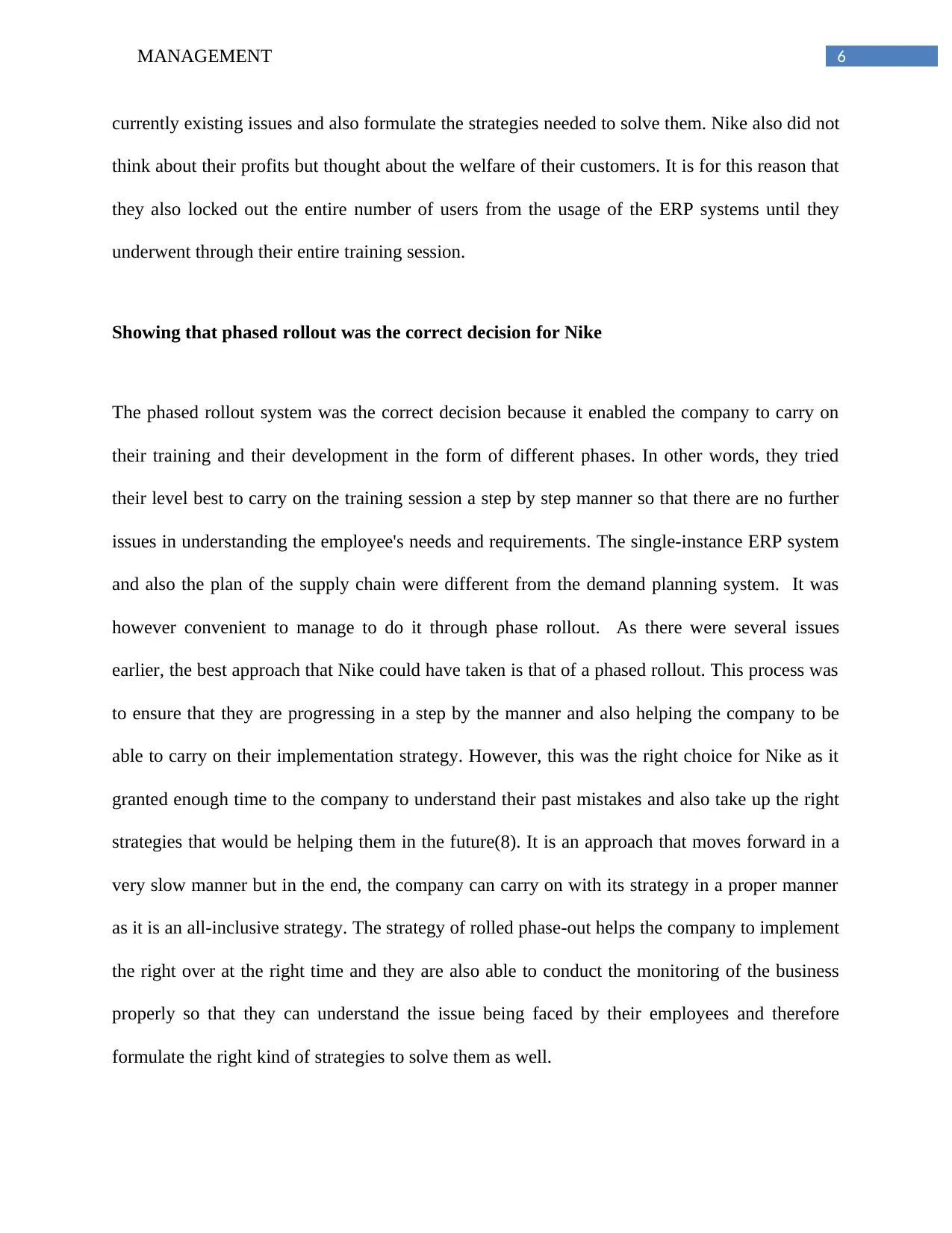
6MANAGEMENT
currently existing issues and also formulate the strategies needed to solve them. Nike also did not
think about their profits but thought about the welfare of their customers. It is for this reason that
they also locked out the entire number of users from the usage of the ERP systems until they
underwent through their entire training session.
Showing that phased rollout was the correct decision for Nike
The phased rollout system was the correct decision because it enabled the company to carry on
their training and their development in the form of different phases. In other words, they tried
their level best to carry on the training session a step by step manner so that there are no further
issues in understanding the employee's needs and requirements. The single-instance ERP system
and also the plan of the supply chain were different from the demand planning system. It was
however convenient to manage to do it through phase rollout. As there were several issues
earlier, the best approach that Nike could have taken is that of a phased rollout. This process was
to ensure that they are progressing in a step by the manner and also helping the company to be
able to carry on their implementation strategy. However, this was the right choice for Nike as it
granted enough time to the company to understand their past mistakes and also take up the right
strategies that would be helping them in the future(8). It is an approach that moves forward in a
very slow manner but in the end, the company can carry on with its strategy in a proper manner
as it is an all-inclusive strategy. The strategy of rolled phase-out helps the company to implement
the right over at the right time and they are also able to conduct the monitoring of the business
properly so that they can understand the issue being faced by their employees and therefore
formulate the right kind of strategies to solve them as well.
currently existing issues and also formulate the strategies needed to solve them. Nike also did not
think about their profits but thought about the welfare of their customers. It is for this reason that
they also locked out the entire number of users from the usage of the ERP systems until they
underwent through their entire training session.
Showing that phased rollout was the correct decision for Nike
The phased rollout system was the correct decision because it enabled the company to carry on
their training and their development in the form of different phases. In other words, they tried
their level best to carry on the training session a step by step manner so that there are no further
issues in understanding the employee's needs and requirements. The single-instance ERP system
and also the plan of the supply chain were different from the demand planning system. It was
however convenient to manage to do it through phase rollout. As there were several issues
earlier, the best approach that Nike could have taken is that of a phased rollout. This process was
to ensure that they are progressing in a step by the manner and also helping the company to be
able to carry on their implementation strategy. However, this was the right choice for Nike as it
granted enough time to the company to understand their past mistakes and also take up the right
strategies that would be helping them in the future(8). It is an approach that moves forward in a
very slow manner but in the end, the company can carry on with its strategy in a proper manner
as it is an all-inclusive strategy. The strategy of rolled phase-out helps the company to implement
the right over at the right time and they are also able to conduct the monitoring of the business
properly so that they can understand the issue being faced by their employees and therefore
formulate the right kind of strategies to solve them as well.
⊘ This is a preview!⊘
Do you want full access?
Subscribe today to unlock all pages.

Trusted by 1+ million students worldwide
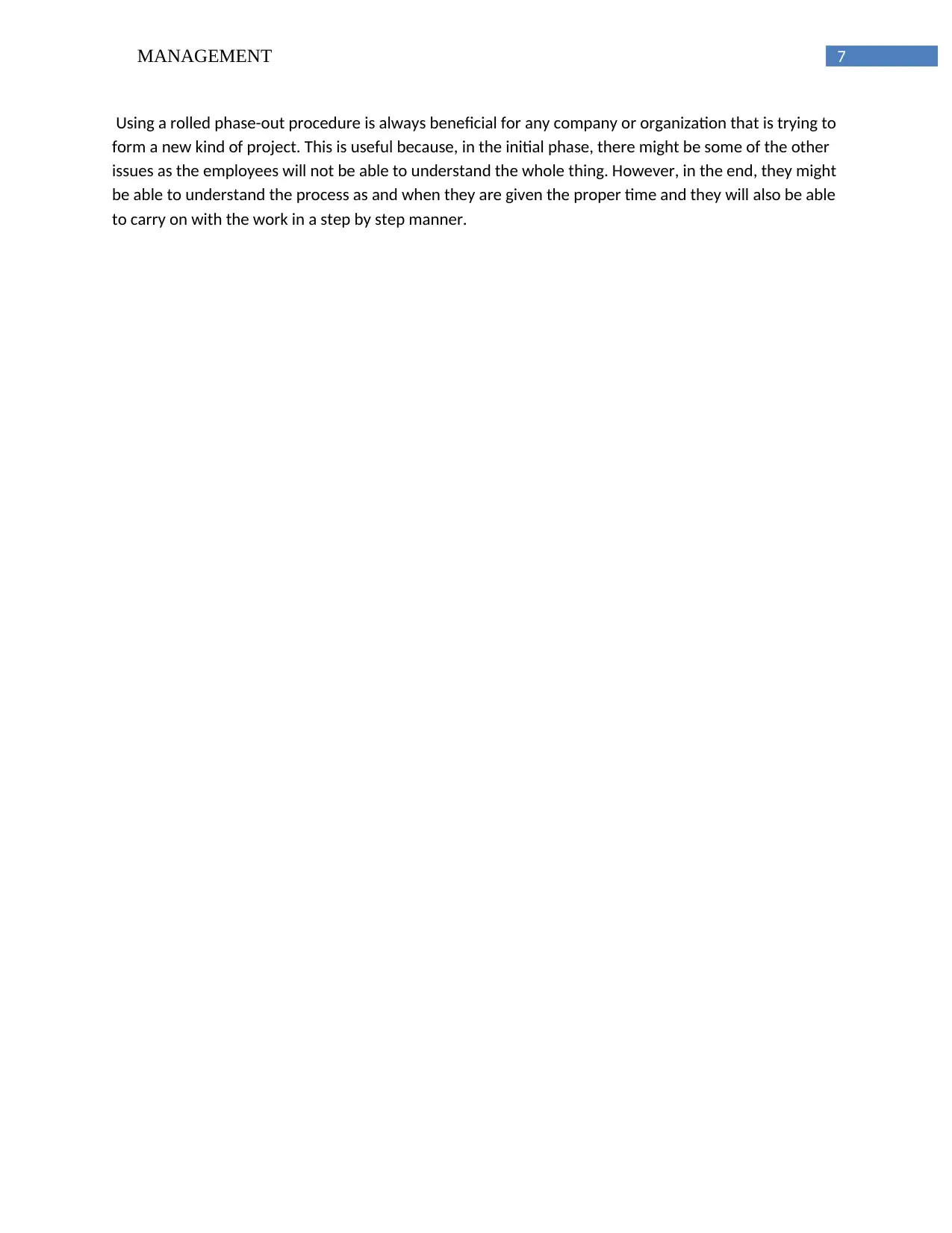
7MANAGEMENT
Using a rolled phase-out procedure is always beneficial for any company or organization that is trying to
form a new kind of project. This is useful because, in the initial phase, there might be some of the other
issues as the employees will not be able to understand the whole thing. However, in the end, they might
be able to understand the process as and when they are given the proper time and they will also be able
to carry on with the work in a step by step manner.
Using a rolled phase-out procedure is always beneficial for any company or organization that is trying to
form a new kind of project. This is useful because, in the initial phase, there might be some of the other
issues as the employees will not be able to understand the whole thing. However, in the end, they might
be able to understand the process as and when they are given the proper time and they will also be able
to carry on with the work in a step by step manner.
Paraphrase This Document
Need a fresh take? Get an instant paraphrase of this document with our AI Paraphraser
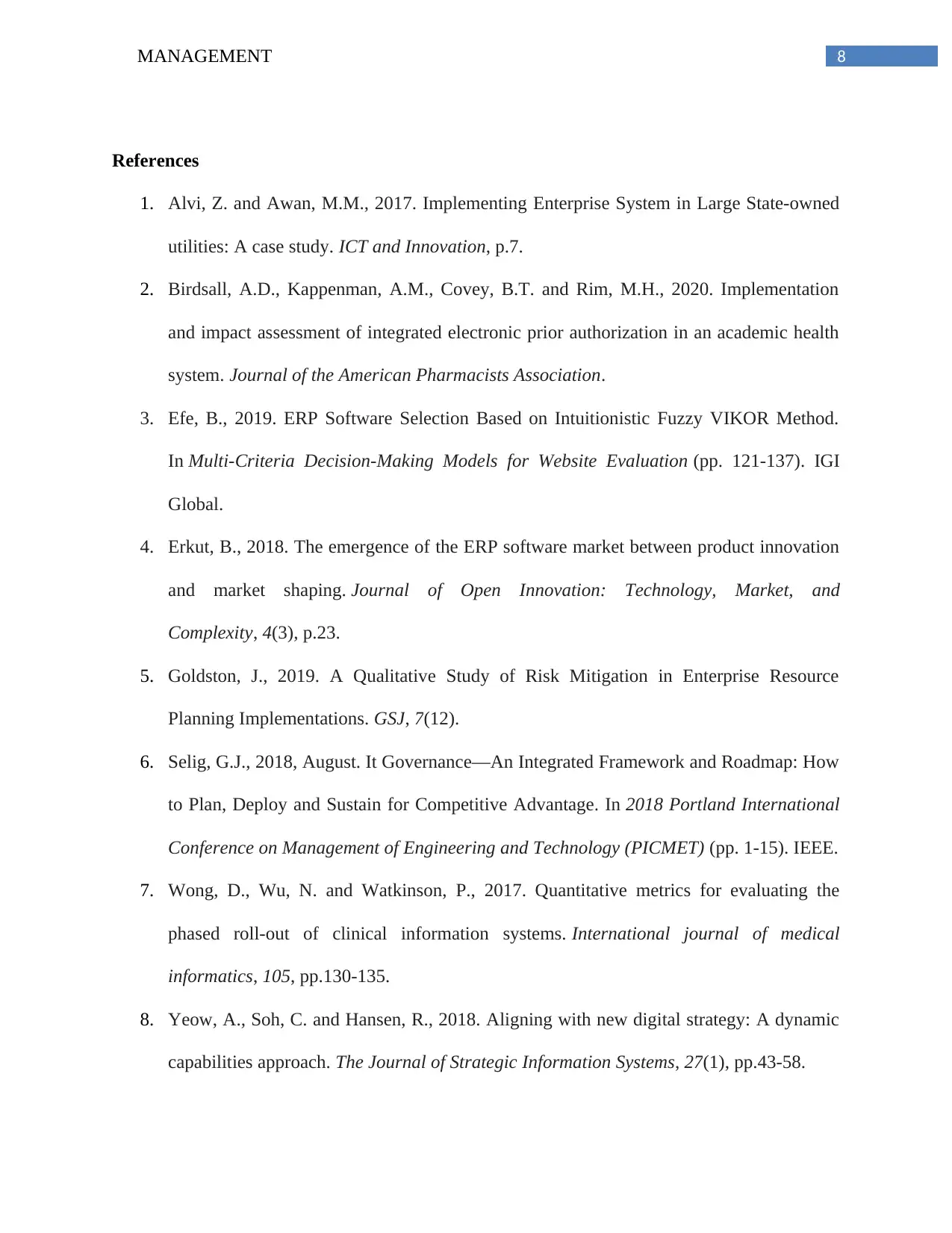
8MANAGEMENT
References
1. Alvi, Z. and Awan, M.M., 2017. Implementing Enterprise System in Large State-owned
utilities: A case study. ICT and Innovation, p.7.
2. Birdsall, A.D., Kappenman, A.M., Covey, B.T. and Rim, M.H., 2020. Implementation
and impact assessment of integrated electronic prior authorization in an academic health
system. Journal of the American Pharmacists Association.
3. Efe, B., 2019. ERP Software Selection Based on Intuitionistic Fuzzy VIKOR Method.
In Multi-Criteria Decision-Making Models for Website Evaluation (pp. 121-137). IGI
Global.
4. Erkut, B., 2018. The emergence of the ERP software market between product innovation
and market shaping. Journal of Open Innovation: Technology, Market, and
Complexity, 4(3), p.23.
5. Goldston, J., 2019. A Qualitative Study of Risk Mitigation in Enterprise Resource
Planning Implementations. GSJ, 7(12).
6. Selig, G.J., 2018, August. It Governance—An Integrated Framework and Roadmap: How
to Plan, Deploy and Sustain for Competitive Advantage. In 2018 Portland International
Conference on Management of Engineering and Technology (PICMET) (pp. 1-15). IEEE.
7. Wong, D., Wu, N. and Watkinson, P., 2017. Quantitative metrics for evaluating the
phased roll-out of clinical information systems. International journal of medical
informatics, 105, pp.130-135.
8. Yeow, A., Soh, C. and Hansen, R., 2018. Aligning with new digital strategy: A dynamic
capabilities approach. The Journal of Strategic Information Systems, 27(1), pp.43-58.
References
1. Alvi, Z. and Awan, M.M., 2017. Implementing Enterprise System in Large State-owned
utilities: A case study. ICT and Innovation, p.7.
2. Birdsall, A.D., Kappenman, A.M., Covey, B.T. and Rim, M.H., 2020. Implementation
and impact assessment of integrated electronic prior authorization in an academic health
system. Journal of the American Pharmacists Association.
3. Efe, B., 2019. ERP Software Selection Based on Intuitionistic Fuzzy VIKOR Method.
In Multi-Criteria Decision-Making Models for Website Evaluation (pp. 121-137). IGI
Global.
4. Erkut, B., 2018. The emergence of the ERP software market between product innovation
and market shaping. Journal of Open Innovation: Technology, Market, and
Complexity, 4(3), p.23.
5. Goldston, J., 2019. A Qualitative Study of Risk Mitigation in Enterprise Resource
Planning Implementations. GSJ, 7(12).
6. Selig, G.J., 2018, August. It Governance—An Integrated Framework and Roadmap: How
to Plan, Deploy and Sustain for Competitive Advantage. In 2018 Portland International
Conference on Management of Engineering and Technology (PICMET) (pp. 1-15). IEEE.
7. Wong, D., Wu, N. and Watkinson, P., 2017. Quantitative metrics for evaluating the
phased roll-out of clinical information systems. International journal of medical
informatics, 105, pp.130-135.
8. Yeow, A., Soh, C. and Hansen, R., 2018. Aligning with new digital strategy: A dynamic
capabilities approach. The Journal of Strategic Information Systems, 27(1), pp.43-58.

9MANAGEMENT
⊘ This is a preview!⊘
Do you want full access?
Subscribe today to unlock all pages.

Trusted by 1+ million students worldwide
1 out of 9
Related Documents
Your All-in-One AI-Powered Toolkit for Academic Success.
+13062052269
info@desklib.com
Available 24*7 on WhatsApp / Email
![[object Object]](/_next/static/media/star-bottom.7253800d.svg)
Unlock your academic potential
Copyright © 2020–2025 A2Z Services. All Rights Reserved. Developed and managed by ZUCOL.





